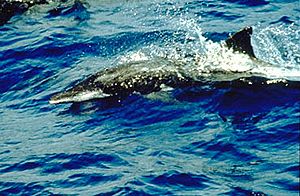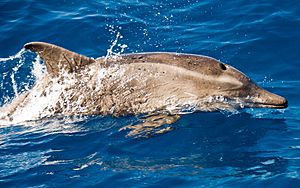Rough-toothed dolphin facts for kids
Quick facts for kids Rough-toothed dolphin |
|
|---|---|
 |
|
 |
|
| Size compared to an average human | |
| Conservation status | |
| Scientific classification | |
| Genus: |
Steno
|
| Species: |
bredanensis
|
 |
|
| Rough-toothed dolphin range | |
The rough-toothed dolphin (Steno bredanensis) is a type of dolphin. It lives in deep, warm, and tropical waters all around the world.
A scientist named Georges Cuvier first described this dolphin in 1823. The name Steno comes from a Greek word meaning 'narrow'. This refers to the dolphin's narrow snout, which is a special feature. This dolphin is the only species in the Steno group.
Description
The rough-toothed dolphin is quite a large dolphin. Adults are usually about 2 to 3 meters (7 to 9 feet) long. They weigh between 90 and 155 kilograms (200 to 340 pounds). Male dolphins are bigger than females.
One of its most noticeable features is its cone-shaped head and thin nose. Other dolphins usually have shorter snouts or a more rounded forehead. As its name suggests, its teeth are also special. They have a rough surface with many small, uneven ridges. These dolphins can have between 19 and 28 teeth in each part of their jaw.
Their flippers are placed further back on their body compared to other dolphins. At sea, people might confuse them with spinner, spotted, or bottlenose dolphins. The dorsal fin (the fin on its back) is easy to see. It is about 18 to 28 centimeters (7 to 11 inches) tall. The sides of the dolphin are light gray. Its back and dorsal fin are a much darker gray. Older dolphins often have pink, yellow, or white marks around their mouth and on their belly.
Where They Live
Scientists do not know much about how many rough-toothed dolphins there are or exactly where they all live. They live in the Pacific, Atlantic, and Indian Oceans. They also live in the Mediterranean Sea. They prefer warm waters, but sometimes they are seen in cooler places. People almost always see them far from shore, in water at least 1 kilometer (0.6 miles) deep. This is beyond the shallow continental shelf area.
Most studies on these dolphins have happened in the eastern Pacific Ocean. Scientists there think there are about 150,000 of them. Old bones of Steno dolphins have been found in Europe. These bones are from a time called the Pliocene period.
In the Mediterranean Sea, people used to think these dolphins just visited from the North Atlantic. But now, scientists know there is a small group that lives there all the time.
Behaviour and Diet
Rough-toothed dolphins usually live in groups. However, sometimes a dolphin is seen swimming alone. An average group has between 10 and 20 dolphins. But groups can be as small as two or as large as 90. These large groups might be temporary. They could be made of smaller, more permanent groups of 2 to 8 family members that join up. These dolphins have also been seen swimming with other types of dolphins. They also swim with pilot whales, false killer whales, and even humpback whales.
Rough-toothed dolphins sometimes "bow-ride." This means they swim in front of boats, riding the waves made by the boat's bow. But they do not do this as often as some other dolphin species. They often "skim" the water. This means they swim with their heads and chins above the surface. They can dive at least 50 meters (164 feet) deep. They can also stay underwater for at least 15 minutes.
These dolphins use echolocation to find food and navigate. Their echolocation clicks are very short. They last less than 0.2 seconds. They also make longer whistles.
Scientists do not know everything about what they eat. But the stomachs of stranded dolphins have shown they eat fish like silversides, sauries, houndfish, smelts, and cutlassfish. They also eat different kinds of squid and octopuses. It is thought that killer whales and sharks hunt rough-toothed dolphins.
Reproduction
Rough-toothed dolphins give birth to one baby at a time. Scientists do not know how long the mother is pregnant. They also do not know if there is a special time of year for them to have babies. Baby dolphins are about 100 centimeters (39 inches) long when they are born. They grow quickly for the first five years of their lives. Female dolphins can start having babies when they are between six and ten years old. Males can start reproducing when they are between five and ten years old.
See also
 In Spanish: Delfín de hocico estrecho para niños
In Spanish: Delfín de hocico estrecho para niños




